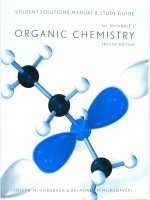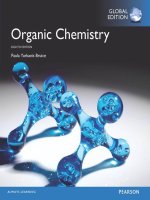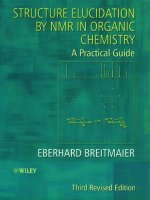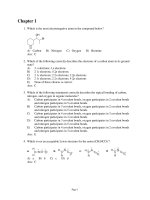Basic organic chemistry by snigdha singh, aarushi singh ramesh chandr
Bạn đang xem bản rút gọn của tài liệu. Xem và tải ngay bản đầy đủ của tài liệu tại đây (7.68 MB, 244 trang )
BASIC ORGANIC CHEMISTRY
BASIC ORGANIC CHEMISTRY
Ramesh Chandra, Snigdha Singh
and Aarushi Singh
ARCLER
P
r
e
s
s
www.arclerpress.com
Basic Organic Chemistry
Ramesh Chandra, Snigdha Singh and Aarushi Singh
Arcler Press
2010 Winston Park Drive,
2nd Floor
Oakville, ON L6H 5R7
Canada
www.arclerpress.com
Tel: 001-289-291-7705
001-905-616-2116
Fax: 001-289-291-7601
Email:
e-book Edition 2020
ISBN: 978-1-77407-424-4 (e-book)
This book contains information obtained from highly regarded resources. Reprinted material
sources are indicated and copyright remains with the original owners. Copyright for images and
other graphics remains with the original owners as indicated. A Wide variety of references are
listed. Reasonable efforts have been made to publish reliable data. Authors or Editors or Publishers are not responsible for the accuracy of the information in the published chapters or consequences of their use. The publisher assumes no responsibility for any damage or grievance to the
persons or property arising out of the use of any materials, instructions, methods or thoughts in
the book. The authors or editors and the publisher have attempted to trace the copyright holders
of all material reproduced in this publication and apologize to copyright holders if permission has
not been obtained. If any copyright holder has not been acknowledged, please write to us so we
may rectify.
Notice: Registered trademark of products or corporate names are used only for explanation and
identification without intent of infringement.
© 2020 Arcler Press
ISBN: 978-1-77407-359-9 (Softcover)
Arcler Press publishes wide variety of books and eBooks. For more information about
Arcler Press and its products, visit our website at www.arclerpress.com
ABOUT THE AUTHORS
Prof. Ramesh Chandra is an outstanding scientist, revered teacher and an exceptionally
successful administrator. He is currently heading Department of Chemistry, University
of Delhi, where he is serving as Professor for the last more than 26 years and Founder
Director of Dr. B. R. Ambedkar Center for Biomedical Research, University of Delhi,
since March 1991. He has been Vice-Chancellor, Bundelkhand University, Jhansi for
six years (1999-2005); Member, Planning Commission, Government of U.P, India as
well as the President of the Indian Chemical Society (2004-2006). Professor Chandra
started his research career at the University of Delhi, thereafter he went to The New
York Hospital-Cornell University Medical Center and the Rockefeller University,
New York; State University of New York at Stonybrook, USA as Assistant Research
Professor. He conducted advanced research at the Harvard University Medical SchoolMassachusetts General Hospital, jointly at MIT, Cambridge, USA. Over the last 38
years, Professor Chandra has contributed largely in the field of Chemical Sciences and
particularly in New Drug Discovery and Development as well as Drug Metabolism. He
has to his credit several patents, published more than 300 original Scientific Research
Papers/ Review Articles in International journals of repute and six of his internationally
acclaimed scientific Books. Prof. Chandra is the recipient of several professional
national/ international recognitions; these includes: Millennium Plaques of Honor (Life
Time Achievement Award for Contribution in Science & Technology) by the Indian
Science Congress Association (ISCA) for 2017-2018, Award of the Highest Honor of
Soka University, Tokyo, Japan (2000); J William Fulbright Scholarship (1993); The
Rockefeller Foundation USA-Biotechnology Career Award (1993); and several others.
Snigdha Singh completed her M.Tech. degree (Chemical Synthesis and Process
Technologies) in 2016 from University of Delhi, India. After that she joined Prof.
Ramesh Chandra group at Department of Chemistry, University of Delhi for her
doctoral studies. She is involved in miscellaneous projects for development of novel
hydroxyethylamine molecules as potent multistage Antimalarial. Her sincere efforts
and excellent performance has culminated her into a keen researcher. Currently, she
is working at University of Siena under the supervision of Prof. Maurizio Taddei
on Synthesis of novel 8-hydroxyquinolines as Gli-1 Hedgehog Inhibitors. She has
successfully optimized complex organic syntheses during her doctoral research. Her
research efforts are directed towards the synthesis of bioactive heterocyclic molecules.
She has already published 9 papers in international and national reputed Journals and
also presented her work in many conferences.
Ms. Aarushi Singh completed her Masters degree in chemistry (2013) from
University of Delhi, Delhi, India. Thereafter, she joined as senior research fellow at
Indian Agricultural Research Institute, Pusa, Delhi, India. Then, she joined Lingaya’s
University, Faridabad, India as Assistant Professor in Chemistry.
TABLE OF CONTENTS
List of Figures ........................................................................................................xi
List of Tables ........................................................................................................xv
List of Abbreviations .......................................................................................... xvii
Preface........................................................................ ................................... ....xix
Chapter 1
Introduction to Chemistry and Organic Chemistry ................................... 1
1.1. Introduction ........................................................................................ 2
1.2. Branches of Chemistry ........................................................................ 3
1.3. Importance And Scope of Chemistry ................................................... 5
1.4. Organic Chemistry.............................................................................. 9
1.5. Origin of Organic Chemistry............................................................. 10
1.6. Applications o Organic Chemistry .................................................... 13
1.7. Conclusion ....................................................................................... 19
Review Questions .................................................................................... 21
References ............................................................................................... 22
Chapter 2
Organic Molecules and Functional Groups ............................................. 23
2.1. Introduction ...................................................................................... 24
2.2. Functional Groups And Reactivity..................................................... 25
2.3. Role of Functional Groups ................................................................ 27
2.4. Alcohols ........................................................................................... 30
2.5. Ethers................................................................................................ 33
2.6. Aldehydes And Ketones .................................................................... 34
2.7. Carboxylic Acids............................................................................... 36
2.8. Physical Properties and Characterization .......................................... 37
Review Questions .................................................................................... 40
References ............................................................................................... 41
Chapter 3
Nomenclature of Organic Molecules ...................................................... 43
3.1. Introduction ...................................................................................... 44
3.2. History of The Nomenclature of Organic Molecules ......................... 45
3.3. Basic Steps For Nomenclature of The Organic Molecules.................. 49
3.4. How To Name Organic Compounds Using The Iupac Rules .............. 51
3.5. Guidelines For The Nomenclature of Organic Molecules .................. 57
Review Questions .................................................................................... 60
References ............................................................................................... 61
Chapter 4
Acids And Bases ...................................................................................... 63
4.1. Introduction ...................................................................................... 64
4.2. Acids ....................................................................................................
4.3. Bases ................................................................................................ 69
4.4. Neutralization................................................................................... 71
4.5. Arrhenius Theory............................................................................... 74
4.6. Bronsted-Lowry Theory ..................................................................... 77
4.7. Lewis Theory..................................................................................... 81
Review Questions .................................................................................... 84
References ............................................................................................... 85
Chapter 5
Understanding Organic Reactions........................................................... 87
5.1. Introduction ...................................................................................... 88
5.2. Types of Organic Reactions ............................................................... 89
5.3. Principal Methods of Forming The Organic Reactions ....................... 91
5.4. Role of Organic Reactions In The Modern World .............................. 94
5.5. Importance of Catalyst In Organic Reactions .................................... 95
5.6. Organic Chemistry Is All Around Us ................................................. 98
Review Questions .................................................................................. 104
References ............................................................................................. 105
Chapter 6
Stereochemistry .................................................................................... 109
6.1. Introduction .................................................................................... 110
6.2. Historical Perspective of Stereochemistry ........................................ 111
6.3. Fundamentals of Stereochemistry.................................................... 115
6.4. Chirality.......................................................................................... 116
viii
6.5. Stereoisomers ................................................................................. 117
6.6. Absolute Configuration And The (R) And (S) System ........................ 121
6.7. Fischer Projections .......................................................................... 124
Review Questions .................................................................................. 127
References ............................................................................................. 128
Chapter 7
Amino Acids And Proteins..................................................................... 131
7.1. Introduction .................................................................................... 132
7.2. Proteins .......................................................................................... 135
7.3. The 20 Amino Acids And Their Role In Protein Structures................ 140
7.4. What Is The Difference Between A Protein And An Amino Acid?..... 150
7.5. What Are Essential Amino Acids? .................................................... 151
Review Questions .................................................................................. 153
References ............................................................................................. 154
Chapter 8
Carbohydrates ....................................................................................... 157
8.1. Introduction .................................................................................... 158
8.2. History Of Carbohydrates ............................................................... 160
8.3. Carbohydrates................................................................................. 161
8.4. Classification and Nomenclature .................................................... 162
8.5. Carbohydrates as The Monosaccharides .......................................... 165
8.6. Disaccharides ................................................................................. 167
Review Questions .................................................................................. 173
References ............................................................................................. 174
Chapter 9
Alcohols And Ethers .............................................................................. 175
9.1. Introduction .................................................................................... 176
9.2. Physical Properties of Alcohols And Ethers ...................................... 178
9.3. Chemical Properties of Alcohols And Phenols................................. 186
9.4. Preparation Of Alcohols.................................................................. 188
9.5. Nucleophilic Properties: Ether Formation ........................................ 190
9.6. Some Commercially Important Alcohols ......................................... 192
Review Questions .................................................................................. 194
References ............................................................................................. 195
ix
Chapter 10 Spectroscopy ......................................................................................... 197
10.1. Introduction .................................................................................. 198
10.2. What Is Spectroscopy.................................................................... 200
10.3. Different Types Of Spectroscopy For Chemical Analysis ................ 200
10.4. What Is Electromagnetic Radiation (EMR)? .................................... 207
10.5. Basic Components Of Spectroscopic Instruments.......................... 208
10.6. Spectroscopy Based On Absorption .............................................. 211
10.7. Conclusion ................................................................................... 212
Review Questions .................................................................................. 214
References ............................................................................................. 215
Index ..................................................................................................... 217
LIST OF FIGURES
Figure 1.1. Representation of the branch of chemistry
Figure 1.2. Representation of organic chemistry
Figure 1.3. Frederich Wöhler provided a breakthrough in the field of organic
chemistry
Figure 2.1. Glucose structure
Figure 2.2. Coffee contains caffeine
Figure 2.3. The representation of an alcohol group
Figure 2.4. Structure of an alcohol group
Figure 2.5. Representation of ether group
Figure 3.1. Different methods are being followed for the nomenclature of
organic molecules in the modern world
Figure 3.2. There is a history for the development of the guidelines of the
nomenclature of the organic molecules
Figure 3.3. There are certain guidelines that have to be followed in the naming
of the organic molecules
Figure 3.4. As the saturated hydrocarbons, there is a different set of rules for the
nomenclature of the alkanes
Figure 3.5. While naming an organic molecule, it is important to recognize the
number of branched chains
Figure 4.1. pH scale with examples of every pH level
Figure 4.2. Blue and red litmus paper
Figure 4.3. Titration using burette and beaker
Figure 4.4. Swedish chemist Svante Arrhenius who gave Arrhenius theory
Figure 4.5. 3D diagram of Bronsted and Lowry theory
Figure 4.6. Image shows the reaction between ammonia and boron trifluoride
(BF3)
Figure 5.1. According to many researchers, the life and all the life-related
functions were started on the planet earth after the initiation of organic reactions
xi
Figure 5.2. The direction of arrow plays a very crucial role in displaying the
direction of the reaction
Figure 5.3. The role of the catalyst is to alter the rate of the reaction and assist
in the completion of the reaction
Figure 5.4. The understanding of the organic reaction is very necessary in the
medicine industry
Figure 5.5. Various variable materials comprise majorly of the organic
compounds and are formed by the organic reactions
Figure 6.1. 1-Bromo-1-chloroethane
Figure 6.2. Orientation of D-glucose and L-glucose
Figure 6.3. Orientation of D-glucose and D-altrose
Figure 6.4. A meso compound and a regular chiral compound
Figure 6.5. Relative priority as per the Cahn-Ingold-Prelog (CIP) rules
Figure 6.6. The stereocenters are labeled as R or S
Figure 6.7. Comparison of glucose and galactose
Figure 7.1. General structure of amino acid
Figure 7.2. General structure of alpha-amino acid
Figure 7.3. Classification of the amino acid and proteins
Figure 7.4. Structure of glycine
Figure 7.5. Structure of alanine
Figure 7.6. Structure of valine
Figure 7.7. Structure of leucine
Figure 7.8. Structure of isoleucine
Figure 7.9. Structure of proline
Figure 7.10. Structure of phenylalanine
Figure 7.11. Structure of tyrosine
Figure 7.12. Structure of tryptophan
Figure 7.13. Structure of serine
Figure 7.14. Structure of threonine
Figure 7.15. Structure of cysteine
Figure 7.16. Structure of methionine
Figure 7.17. Structure of asparagines
xii
Figure 7.18. Structure of glutamine
Figure 7.19. Structure of lysine
Figure 7.20. Structure of arginine
Figure 7.21. Structure of histidine
Figure 7.22. Structure of aspartate
Figure 7.23. Structure of glutamate
Figure 7.24. Chemical structure of amino acid
Figure 9.1. Nomenclature of alcohol
Figure 9.2. Isomeric representation
Figure 9.3. 3-methyl-2-pentanone synthesis
Figure 9.4. Synthesis of metronidazole
Figure 9.5. Williamson-ether-synthesis
Figure 9.6. Ether peroxide formation
Figure 9.7. Ether
Figure 10.1. Ultraviolet-visible spectroscopy
Figure 10.2. Infrared spectroscopy
Figure 10.3. Nuclear magnetic resonance spectroscopy
Figure 10.4. Electromagnetic wave
xiii
LIST OF TABLES
Table 4.1. Some acids and their conjugate bases
LIST OF ABBREVIATIONS
AAS
atomic absorption spectroscopy
AES
atomic emission spectroscopy
AFS
atomic fluorescence spectroscopy
BF3
boron trifluoride
CIP
Cahn-Ingold-Prelog
DNA
deoxyribonucleic acid
EMR
electromagnetic radiation
IACS
International Association of Chemical Societies
IR
infrared
ISO
International Organization for Standardization
IUPAC
International Union of Pure and Applied Chemistry
IUPAP
International Union of Pure and Applied Physics
NMR
nuclear magnetic resonance
SERS
surface-enhanced Raman spectroscopy
SI
International System of Units
UV
ultraviolet
PREFACE
Subject and Content
Organic chemistry is a field of chemistry that deals in the study of the
compounds containing carbon. It deals with the structural analysis, properties,
composition, reactions related to those compounds, and the processes related to
their preparation. The organic chemistry also lists all the uses and applications
of the compounds that fall under the field of study.
Organic chemistry plays a significant role in the preparation of various materials
and products in the field of manufactured and processed goods. It explains the
various phenomena related to the synthesis of compounds and the manner in
which they can be reacted with each other to form new products.
The motive of this book is to elaborate on the various aspects of organic
chemistry and the related fields. It dwells on the preparation of various organic
compounds and discusses the ways in which those compounds may be used
further to form new products and goods that can be applied in various sectors.
Salient Features of the Book
•
•
•
The book introduces the readers to chemistry and explains them the
various aspects related to the subject. It discusses the various elements
related to the field of chemistry. It explains the several applications of
chemistry and its uses in their daily lives. It also explains the various
fields that originate from the main chemistry and dwells upon their
classification and fundamentals related to those fields.
The book goes on to explain organic chemistry to the readers. It explains
how the various molecules group themselves together to form certain
structures in the organic chemistry. It explains various kinds of shapes
and forms that the compounds form and also enlists several functional
groups that exist in the organic chemistry. The book dwells upon the
classification of the organic compounds based on these functional groups
and the structures they form resulting from it.
Moving further, the book dwells upon the procedures that are used for
the nomenclature of the organic compounds. It lists all the standards that
need to be followed while naming a compound. It also enlists various
groups that are referenced when naming a compound and the use of
bonds while doing so.
• The book goes on to explain the meaning and relevance of acids and
bases in the organic chemistry. It elaborates upon the significance of both
the types in the compounds and explains how the various properties of
the compounds vary according to what group they belong to.
• The book dwells upon the subject of understanding how the reactions go
through in organic chemistry. In the organic chemistry, there is generally
rue to the way reactions happen, and the book explains the methods and
rules to the readers in detail.
• The book further goes on to define the roles of ethers, alcohols, aldehydes,
amino acids, carbohydrates, and other such groups in characterizing
several compounds in organic chemistry. It dwells upon the significance
of each of these groups in the organic chemistry and establishes ways
in which they react with each other and form various compounds and
products.
This book has been compiled to elaborate on the subject of organic chemistry
and its relevance in the modern world. It lists various aspects related to the field
of organic chemistry and tries to discover the aspects related to this field of
chemistry in detail.
xx
1
INTRODUCTION TO
CHEMISTRY AND
ORGANIC CHEMISTRY
LEARNING OBJECTIVES:
Chemistry is a branch of science concerned with the study of matter
and its reactions. The learning objectives of this chapter are to gain an
understanding of the following:
•
•
•
•
•
•
The field of chemistry.
The various branches of chemistry.
Importance and scope of chemistry.
The sub-discipline of organic chemistry.
The history of organic chemistry.
Applications of organic chemistry.
KEY TERMS:
•
•
•
•
•
Analytical chemistry
Cleansing agents
Inorganic chemistry
Organic chemistry
Quantum mechanics
•
•
•
•
Sterilizing agents
Textiles and clothing
Thermodynamics
Three-dimensional structure of
the compound
2
Basic Organic Chemistry
1.1. INTRODUCTION
Chemistry is defined as a branch of science that studies the matter
and the reactions it undergoes. Other branches of science like physics,
biology, and geology also deal with the study of matter. But chemistry
is the only branch that deals with the reactions that matter undergoes.
It includes a study of the composition of the matter, its structure,
properties, and its reactions. Chemistry is a complex and fascinating
subject.
Chemistry provides an answer to most of the questions regarding
how or why something is in the natural world. For example, the reason
behind the sky appearing blue. The color depends on the chemical
composition of the substances and the light they reflect. Example of
another simple question related to chemistry is how an insect walks on
the surface of the water without drowning. The unique properties of
water provide a high surface tension, which does not let small objects
sink. Chemistry surrounds us and anything that concerns matter has its
answer in chemistry (Figure 1.1).
Figure 1.1: Representation of the branch of chemistry.
Source: />
Chemists make new compounds by understanding the reactions
between elements and compounds. Chemistry finds its applications in
Introduction to Chemistry and Organic Chemistry
the chemical and pharmaceutical industry. It is
used in making plastics, ceramics, fillers, alloys,
drugs, etc.
The target compound is synthesized using
chemical reactions under conditions that are
determined optimum so that output is produced
in a cost-effective manner. The compound is
purified after the best conditions are identified
and finally identified by chemists. The process
of identification is to ensure that the compound
contains all elements in the right proportion and
also the determination of the three-dimensional
structure of the compound.
1.2. BRANCHES OF CHEMISTRY
Chemistry is divided into many branches or
disciplines since it is a vast subject. Dividing it
into manageable topics helps more accurately.
The main branches are organic chemistry,
inorganic chemistry, analytical chemistry,
physical chemistry, and biochemistry.
1.2.1. Organic Chemistry
It involves the study of carbon and its compounds
that make up living things. It is basically the
chemistry of life.
1.2.2. Inorganic Chemistry
Inorganic chemistry covers the study of
compounds that is not a part of organic chemistry.
Its studies compounds that are inorganic, and
does not contain a C-H bond. Many inorganic
compounds contain metals.
Compound means
to combine;
a compound is a
combination or
mixture of two or
more things.
3









